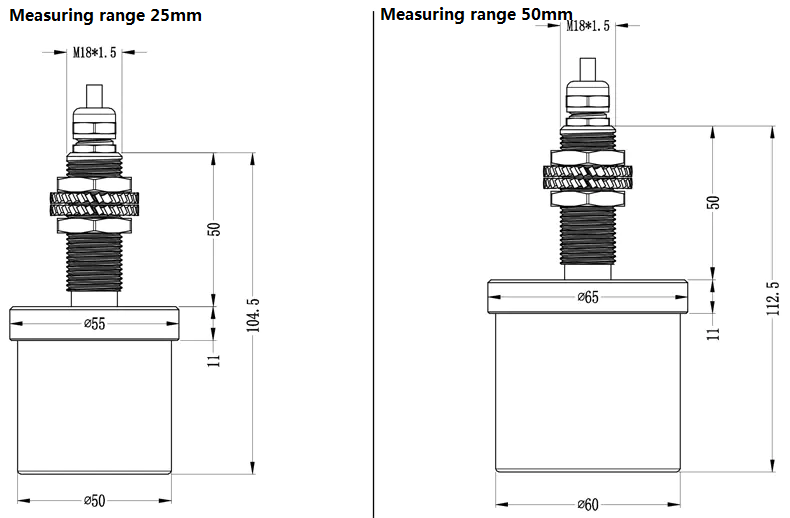5, the influence of the surface processing status of the measured body on the sensor measurement results
The surface finish of the measured body facing the probe also affects the measurement results! The non-smooth surface of the measured body will bring a large additional error in the actual measurement application, especially for vibration measurement, the error signal is superimposed with the actual vibration signal, and it is difficult to separate electrically, so the measured surface should be smooth and clean. There should be no defects such as nicks, holes, bumps, grooves, etc. (except for bumps or grooves specially installed for key phasers and speed measurements). Generally, the measured surface roughness of vibration measurement is required to be between 0.4um and 0.8um; For displacement measurement, the measured surface roughness is required to be between 0.4um and 1.6um. If this cannot be met, the surface to be measured needs to be refined or polished.
6, the influence of residual magnetic effect on the sensor
The eddy current effect is mainly concentrated on the surface of the measured body. If the residual magnetic effect is formed during the processing, the characteristics of the sensor will be affected by uneven quenching, uneven hardness, uneven metallographic structure, and uneven crystalline structure. During vibration measurement, if the residual magnetic effect on the surface of the measured body is too large, the measurement waveform will be distorted.
7, the influence of the surface size of the measured body on the sensor
The range of magnetic field generated by the probe coil is certain, and the eddy current field formed on the surface of the measured body is also certain. In this way, there are certain requirements for the surface size of the measured body. In order to prevent the magnetic field generated by the eddy current from affecting the normal output of the instrument, a certain range of non-conductive media space must be left around the sensor head when installed, if more than two sensors are installed at the same time in a certain part, it is necessary to consider whether cross interference will occur, and the specified distance between the two probes must be maintained.
Usually, when the surface of the measured body is flat, the probe center line is directly facing
8, the influence of the surface coating of the measured body on the sensor
The influence of the coating on the surface of the measured body on the sensor is equivalent to changing the material of the measured body. Depending on the material and thickness of the coating, the sensitivity of the sensor will change slightly.
9, the influence of high-frequency coaxial cable on the sensor
High frequency coaxial cable is also a major factor affecting the electrical performance of eddy current sensors. Because the sensor works in a high frequency state (oscillation frequency about 1MHZ), the frequency attenuation, temperature characteristics, impedance, length, etc. of the high frequency coaxial cable have become factors affecting the performance of the sensor!
10, the influence of external magnetic field on the sensor
Eddy current sensor is an inductive sensor, because its main principle is the eddy current effect, so the influence of external magnetic field should be fully considered in engineering applications! Strong external magnetic field will definitely affect the performance of the sensor.
For the external static magnetic field, because the strength of the static magnetic field is certain, the direction and eddy current magnetic field may present various conditions, and once the direction of the external static magnetic field is determined, its interference with the eddy current magnetic field is also certain. Therefore, in practical engineering applications, the influence of static magnetic field can measure the change of sensor sensitivity through field tests and eliminate it through subsequent circuits or software algorithms.
For external alternating magnetic fields, such as large exciter, frequently started large motor, starter, etc., the direction and strength of the magnetic field may not be a definite value, so the amount generated needs to keep the eddy current sensor away from the range of the alternating magnetic field, or take magnetic field shielding measures to minimize the impact.
Acceptance and storage of eddy current:
one Acceptance check
1. Remove all parts of the system from the packing box. Check for any damage caused by improper transportation. If so, it shall immediately negotiate with the carrier to lodge a claim and report the situation to the company.
2, check the order and packing list to check whether the goods are complete, product model specifications are correct. If it is a complete order, the system is connected, and the power is switched on to check whether the static characteristics of the system comply with the indicators indicated in the factory verification list, usually these indicators should be in accordance with the technical specifications specified in the appendix or the agreed technical agreement.
3, if the product is in good condition, and not immediately installed and used, it is best to carefully put all parts back into the original packaging box, sealed and stored for future use.
4, if the acceptance is not qualified, please contact the company as soon as possible.
two storage
If not used for a long time, the sensor system should be stored in a clean room where the temperature is between -30 ° C and 70 ° C and the relative humidity is not greater than 90%, and the indoor air must not contain corrosive gases. If the storage period is more than one year, it should be newly calibrated before use.
Three. Specimen material
Unless specifically stated at the time of ordering, the sensor system is usually calibrated using 40CrMO material samples before leaving the factory, and only the material of the tested body of the same series can produce the characteristic equation similar to that of 40CrMO; When the material of the tested body is very different or completely different from the 40CrMO composition, please explain or provide a sample of the tested body material when ordering.







